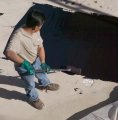
CCW-525 is a liquid-applied, single-component modified polyurethane for vertical and horizontal surfaces. (Photo courtesy of Carlisle Coatings & Waterproofing.)
Liquid-applied membranes (LAMs) are applied in the field using a variety of liquid components that are installed directly to the substrate. These liquid systems usually require a primer and then a multiplecoat application of the liquid materials. Multiple coats are needed to overcome any problems caused by the surface tension of the substrate, such as pinholing. The number of coats necessary can vary from manufacturer to manufacturer depending on the material type and its viscosity. Some manufacturers require two layers of liquid material with a sheet of fibrous matting in between. This creates a stronger waterproofing barrier.

LAMs are applied in the field using a variety of liquid components that are installed directly to the substrate and cure to form a seamless sheet. (Photo courtesy of Mule-Hide Products.)
LAMs for waterproofing are available in the following types:
• Hot-applied or cold-applied polymer modified asphalt.
• Single-component, coal tar modified urethane.
• Two-component urethane.
SEBS
The manufacturing process of modified bitumen adhesive (SEBS) is similar to the emulsion process except polymers, such as rubber, are added to the asphalt. The modified asphalt blend is mixed with the water and clay stabilizers. Waterborne products cure with heat - the greater the heat, the quicker the cure time. In contrast to solvent-based products, humidity slows down the curing process. These products do not have the same chemical resistance of other liquid materials, which can limit their life cycle.
The hot-applied systems have crack-bridging capabilities, higher chemical resistance and longer life cycles. These systems can be applied up to 180 mils, as opposed to other LAMs that top out at 60 mils.
Coal Tar Modified Urethane
Coal tar extenders are added to urethane to provide an effective waterproofing material. The addition of the coal tar reduces the cost of the material. It can also limit the elastomeric capabilities and chemical resistance of the material.

D-Max is a two-component water-based system that sprays on brown and cures black. The waterproof membrane has an elongation of more than 1,000 percent. (Photo courtesy of DeWitt Products Co.)
Urethane systems are available in one- or twocomponent compositions. They are solvent based and require that substrates be completely dry prior to application or blistering can occur. They are highly elastic and have good resistance to soil chemicals and alkalines.
Advantages of LAMs
LAMs are applied as a liquid and cure to form a seamless sheet. This monolithic application is free of seams and voids that can be formed at these vulnerable connections. Another primary advantage of LAMs is their elastomeric capabilities. They have been tested to elongation levels of over 500 percent (ASTM C-836), which enables them to bridge substrate cracks up to 1⁄16 of an inch in width. Another advantage is their self-flashing installation ability. The materials can be applied at vertical-horizontal (floor-wall) junctures without accessories.
Disadvantages of LAMs
Application methods can be a distinct advantage of LAMs. However, the materials must be applied in accordance with precise tolerances to meet the required mil thickness. Due to the fact that application thickness is controlled in the field, meeting these requirements is difficult. Too much material or too little material can decrease the service life. These materials also require dry substrates for application. Application over damp or uncured surfaces could lead to blistering. The other disadvantage is that most LAMs are manufactured with chemical additives that can be toxic or non-VOC compliant. Make sure the material is within local environmental requirements prior to application.

Some LAMs offer not only high elongation levels but self-sealing properties, which allow the membrane to reseal to itself after minor punctures. (Photo courtesy of DeWitt Products Co.)
LAMs can be applied with hot or cold polymer modified asphalts. Hot-applied systems are heated to 400 degrees Fahrenheit in specialized equipment and applied in thicknesses up to 180 mils. The most important design criteria for improved material performance are the materials solids content and coat- ing thickness. The materials solids content should be a minimum of 80 percent to reduce the probability of pinholing. The minimum specified coating thickness should be 60 mils. This is required to reduce stress concentration from irregular substrate conditions, such as cracks, honeycombs, etc.
These systems allow for both above-grade and below-grade application, including planters and splitslab construction. They are not resistant to ultraviolet weathering and cannot withstand foot traffic, so they should not be applied on exposed areas. When LAMs are applied on horizontal applications, a sub-slab must be in place for application of the membrane. A topping of concrete, tile or other hard finishes is required. LAMs are applicable over concrete, masonry, metal and wood surfaces.
LAMs can be applied with brushes, rollers, trowels, or squeegees. Check with the specific manufacturer to determine application preferences for all substrates. One-coat applications should be applied to a 1⁄16-inch thickness. Two-coat systems, reinforced with a woven glass or polyester felt, are typically hot applied and can be installed up to 200 mils in thickness. Due to the fact that the success of the system is reliant on application thickness, mil thickness should be gauged throughout the entire process.
Substrate irregularities will decrease mil thickness and should be accounted for during application. In areas with lower than required mil thickness, additional coats are required. The substrate must be properly prepared, fully cured, and free of moisture and irregularities such as sharp fins, honeycombs and cracks.
All of the materials and application methods, including mil thickness, shall be completed in accordance with the material manufacturers latest printed specifications. Due to the stringent application tolerances required for system success, it is a best practice to specify that the manufacturer provide technical inspections throughout the application to ensure compliance.